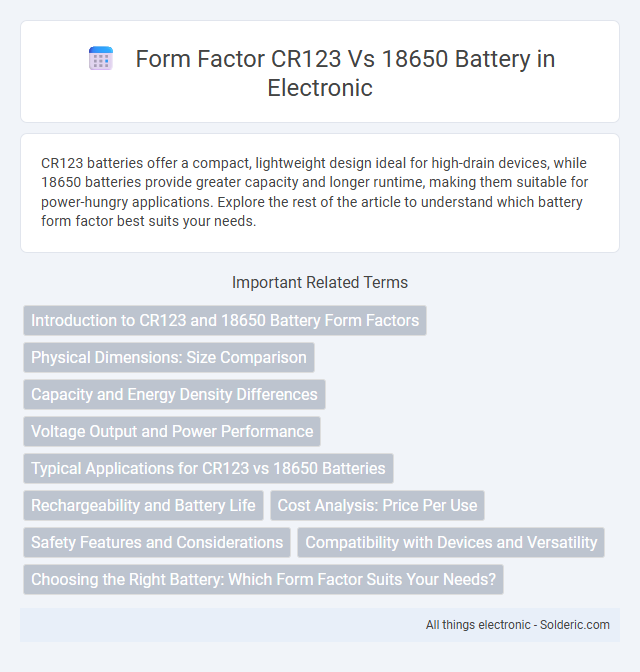CR123 batteries offer a compact, lightweight design ideal for high-drain devices, while 18650 batteries provide greater capacity and longer runtime, making them suitable for power-hungry applications. Explore the rest of the article to understand which battery form factor best suits your needs.
Comparison Table
| Specification | CR123 Battery | 18650 Battery |
|---|---|---|
| Form Factor | CR123 (cylindrical, compact) | 18650 (cylindrical, larger) |
| Dimensions | 34.5mm length, 17mm diameter | 65mm length, 18mm diameter |
| Nominal Voltage | 3V (primary lithium) | 3.6-3.7V (rechargeable lithium-ion) |
| Capacity | Approx. 1400mAh | 1800-3500mAh |
| Rechargeable | No (primary battery) | Yes (lithium-ion) |
| Typical Use | Flashlights, cameras, security devices | Laptops, power tools, e-cigarettes |
| Weight | Approx. 16-17g | Approx. 45-50g |
| Discharge Rate | Low to moderate | High (depends on model) |
| Cost | Moderate to high | Moderate |
Introduction to CR123 and 18650 Battery Form Factors
CR123 batteries are compact, cylindrical cells typically measuring 34.5mm in length and 17mm in diameter, commonly used in high-performance flashlights and security devices. The 18650 battery, larger at 65mm long and 18mm in diameter, is widely favored in laptops, electric vehicles, and portable electronics for its higher capacity and rechargeable capability. Both form factors offer distinct advantages: CR123 excels in lightweight, high-discharge applications, while 18650 provides greater energy storage and rechargeability in a bulkier size.
Physical Dimensions: Size Comparison
The CR123 battery measures approximately 34.5mm in length and 17mm in diameter, making it significantly smaller and more compact than the 18650 battery, which typically measures 65mm in length and 18mm in diameter. This size difference results in the 18650 being nearly twice as long and slightly wider, impacting compatibility and application in various devices. The compact CR123 is favored for lightweight, portable electronics, while the larger 18650 offers greater capacity and energy density, suitable for high-drain devices and extended use.
Capacity and Energy Density Differences
CR123 batteries typically offer capacities around 1500 mAh with high energy density suited for compact devices, while 18650 batteries provide significantly higher capacities ranging from 2500 to 3500 mAh, delivering greater total energy storage. The 18650's cylindrical form factor allows for improved volumetric energy density, making it ideal for applications requiring longer runtimes and higher power output. Although CR123 cells excel in compactness and reliability at high discharge rates, 18650 batteries dominate in capacity and sustained energy delivery for larger-scale electronic devices.
Voltage Output and Power Performance
CR123 batteries typically provide a voltage output of 3 volts, making them ideal for compact devices requiring stable power in short bursts. In contrast, 18650 batteries offer a higher voltage of 3.6 to 3.7 volts with significantly greater capacity and sustained power performance, suitable for high-drain applications. Your choice between these form factors depends on the balance between device size constraints and the need for longer-lasting, consistent energy delivery.
Typical Applications for CR123 vs 18650 Batteries
CR123 batteries are commonly used in high-drain devices such as tactical flashlights, security cameras, and smoke detectors due to their compact size and high discharge rates. 18650 batteries are favored in applications requiring larger capacity and rechargeable options, including laptops, electric vehicles, and high-performance flashlights. The choice between CR123 and 18650 depends on specific energy requirements, device size constraints, and rechargeability needs.
Rechargeability and Battery Life
CR123 batteries are typically non-rechargeable lithium primary cells with limited battery life, making them ideal for short-term, high-drain devices. In contrast, 18650 batteries are rechargeable lithium-ion cells offering significantly longer lifespan and the convenience of multiple charge cycles. Selecting your battery depends on whether you prioritize disposable convenience or cost-effective rechargeability and extended battery life.
Cost Analysis: Price Per Use
CR123 batteries typically have a higher cost per use compared to 18650 batteries because they offer fewer recharge cycles and lower capacity, resulting in more frequent replacements. In contrast, 18650 batteries provide better long-term value due to their larger energy storage and rechargeable nature, reducing your overall energy expenses. Evaluating price per use highlights that 18650 batteries are more cost-effective for devices with high power consumption or frequent usage.
Safety Features and Considerations
CR123 batteries feature a compact design with built-in protection circuits against over-discharge, short-circuit, and overheating, making them safer for high-drain devices and emergency equipment. In contrast, 18650 batteries, often used in larger electronics and electric vehicles, require external battery management systems (BMS) to prevent risks like thermal runaway, overcharging, and potential explosions. Proper handling and quality assurance are critical for 18650 cells due to their higher energy capacity and inherent volatility compared to the more stable but lower-capacity CR123 cells.
Compatibility with Devices and Versatility
The CR123 battery's compact 34mm length and 17mm diameter make it ideal for specialized devices like high-powered flashlights, security cameras, and smoke detectors, while the larger 65mm length and 18mm diameter of the 18650 battery deliver higher capacity and power, suiting laptops, electric vehicles, and power tools. The 18650's rechargeable lithium-ion chemistry enhances versatility across diverse applications requiring sustained power, whereas CR123 batteries are often non-rechargeable lithium-based cells preferred for small, portable electronics with lower power demands. Device compatibility depends on size constraints and power requirements, with 18650 batteries dominating high-capacity, rechargeable device markets and CR123 batteries favored for compact, single-use or occasional-use devices.
Choosing the Right Battery: Which Form Factor Suits Your Needs?
CR123 batteries offer a compact and lightweight form factor ideal for high-drain devices like tactical flashlights and cameras, providing reliable power in a smaller size. In contrast, 18650 batteries deliver higher capacity and longer runtimes, making them suitable for devices requiring extended usage, such as laptops and high-performance flashlights. Your choice depends on balancing size constraints and energy needs to ensure optimal performance for your device.
Form factor CR123 vs 18650 battery Infographic

 solderic.com
solderic.com